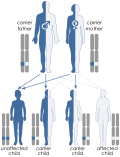Gene
Genes are parts of DNA. DNA is a molecule inside a cell that carries the instructions for making the proteins the cell will need. Each gene contains one or more sets of instructions These instructions usually code for a particular protein. (For example coding for the protein that would make your hair brown, or blonde). Humans have about 20,000 genes that code proteins and many more that are non-coding. Half of a person's genes come from the mother. The other half come from the father.
The definition
Originally: a hereditary unit which occupies a specific position (locus) on a chromosome.[1] Other definitions are ways the gene showed itself:
- 1. A unit which has one or more specific effects on the phenotype of an organism;
- 2. A unit that can mutate to various alleles;
- 3. A unit which recombines with other such units.
Modern definitions must take note of later discoveries.[2] There are now two classes of genes:[3]p173
- 1. genes that are transcribed into RNAs and are translated into polypeptide chains.
- 2. genes whose transcripts (tRNAs, rRNAs, snRNAs) are used directly. These are operators which serve as 'regulatory sequences' during transcription and translation of the DNA."The building blocks of life."
What genes do?
Genes are passed on from parent to child and are an important part of what decides how children look and act (their biological properties). Genes affect the way our bodies work, including how we look. Our eye, hair and skin color are decided by genes. It is said that genes cause genetic effects in our bodies.
A gene may be dominant or recessive.[4] These terms refer to the effect a gene has on the offspring who carry it in their genome.
For example, let's say a mother only has genes for brown hair and a father only has genes for red hair. The child will inherit – receive – genes for red hair (from her father) and brown hair (from her mother). The brown hair gene is 'dominant' to the red hair gene. This means the child will have brown hair even though she has genes for both red and brown hair. This means only one dominant gene is needed for the child to receive that particular trait, while two recessive genes are needed for one.[5]
A recessive trait might stay hidden for many generations. Let us use the child from the last example. We will call her "Mary". Mary has brown hair but has genes for both red and brown hair. Let us say Mary grew up and married Tom. Tom also has brown hair, but like Mary one of his parents had red hair. This means Tom has genes for both red and brown hair. Mary and Tom would each have a chance of passing either brown or red hair genes to their children. This means that the children of Mary and Tom could have either red or brown hair. This explains why a person might look different from their parents, but look like their grandparents or great-grandparents.
Structure and function
The structure of a gene has many elements: the actual protein coding sequence is only a small part. There are DNA regions that are not transcribed as well as untranslated regions of the RNA.[6][7]
Gene Media
The chemical structure of a four base pair fragment of a DNA double helix. The sugar-phosphate backbone chains run in opposite directions with the bases pointing inward, base-pairing A to T and C to G with hydrogen bonds.
Micrographic karyogram of human male, showing 23 pairs of chromosomes. The largest chromosomes are around 10 times the size of the smallest.
- Schematic karyogram of a human, with annotated bands and sub-bands. It shows dark and white regions on G banding. It shows 22 homologous chromosomes, both the male (XY) and female (XX) versions of the sex chromosome (bottom right), as well as the mitochondrial genome (at bottom left).
Schematic of a single-stranded RNA molecule illustrating a series of three-base codons. Each three-nucleotide codon corresponds to an amino acid when translated to protein.
Protein coding genes are transcribed to an mRNA intermediate, then translated to a functional protein. RNA-coding genes are transcribed to a functional non-coding RNA (PDB 3BSE).
Inheritance of a gene that has two different alleles (blue and white). The gene is located on an autosomal chromosome. The white allele is recessive to the blue allele. The probability of each outcome in the children's generation is one quarter, or 25 percent.
Depiction of numbers of genes for representative plants (green), vertebrates (blue), invertebrates (orange), fungi (yellow), bacteria (purple), and viruses (grey). An inset on the right shows the smaller genomes expanded 100-fold area-wise.
Gene functions in the minimal genome of the synthetic organism, Syn 3
Related pages
- Allele#Dominance
- Sequence analysis
- Genetics
- ENCODE, the complete analysis of the human genome
- Gene therapy
- Genetic disorder
References
- ↑ Carlson E.A. 1989. The gene: a critical history. Iowa State reprint. ISBN 978-0813814063
- ↑ Keller, Evelyn Fox 2000. The century of the gene. Harvard.
- ↑ King R.C. Stansfield W.D. & Mulligan P.K. 2006. A dictionary of genetics, 7th ed. Oxford.
- ↑ These are not the only possibilities: see Allele#Dominance.
- ↑ "Mendelian Genetics". www.ndsu.edu. Archived from the original on 2023-06-06. Retrieved 2025-01-08.
- ↑ Alberts B. et al 2002. Molecular biology of the cell. 4th ed, New York: Garland Science. ISBN 978-0-8153-3218-3
- ↑ See also transcription (genetics)









